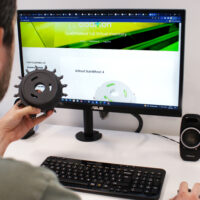Navigating Maintenance Strategies: From Reactive to Predictive and Beyond
In the realm of industrial operations and facility management, the approach to maintenance has undergone a significant transformation over recent years.
Historically, maintenance has often been viewed as a financial burden within organisations – so-called “unnecessary” expenditures incurred for hiring maintenance personnel and procuring spare parts without directly contributing to revenue generation. This perception would pose challenges in persuading management to allocate resources towards maintenance initiatives.
Nowadays, it should not come as a shock to management that maintenance accounts for 20-50% of the total operating budget[i]. Although traditional reactive methods like “run to fail” are giving way to more proactive strategies such as Planned Preventative Maintenance (PPM) and the cutting-edge Predictive Maintenance (PdM), there is still some resistance against full adoption of such maintenance strategies. So, what is the difference between these practices? How do they benefit business operations and what factors need to be addressed to welcome adoption within your business?
Understanding Maintenance Practices:
-
Run to Fail (RTF):
Run to Fail is a reactive approach where maintenance activities are only performed after a component or equipment fails. Although seemingly straightforward, this method often leads to costly unplanned downtime, emergency repairs, and potential safety hazards. Running a piece of equipment to the point of failure (i.e. unplanned) costs, on average, ten times as much as a regular maintenance program would[ii].
Although reactive maintenance cannot always be avoided, companies relying solely on RTF may find themselves caught in a cycle of firefighting rather than proactive maintenance.
-
Planned Preventative Maintenance (PPM):
Favoured by 80% of maintenance personnel [iii], PPM involves scheduling regular maintenance tasks based on predetermined intervals or criteria. When first implementing a PPM strategy these intervals may be a best guess or based on past downtime. As maintenance engineers regularly service parts and develop a deeper understanding of their machines a more robust schedule can develop. By adhering to a planned schedule, organisations can minimise unexpected breakdowns, extend equipment lifespan, and optimise operational efficiency. PPM lays the foundation for a more systematic approach to maintenance, reducing the likelihood of large, costly disruptions.
-
Predictive Maintenance (PdM):

Predictive Maintenance represents the next frontier in maintenance practices, leveraging advanced technologies such as IoT sensors, data analytics, and machine learning algorithms. PdM can reduce machine downtime by 30%-50% and increase equipment life by 20%-40%.
Rather than relying on fixed schedules or guesswork, PdM uses real-time data to anticipate equipment failures before they occur. By detecting subtle changes in performance or condition, organisations can proactively address issues, optimise maintenance schedules, and maximise asset uptime.
54% of global manufacturers surveyed by ATS use predictive maintenance technologies to reduce operational costs involved in maintaining their equipment.
The Synergy Between Predictive and Preventative Maintenance:
While PPM provides a structured framework for maintenance activities, PdM enhances its effectiveness by introducing predictive capabilities. By integrating predictive analytics into existing maintenance strategies, companies can:
- Identify potential failures earlier, minimising unplanned downtime and production losses
- Optimise resource allocation by prioritising maintenance tasks based on actual equipment health
- Reduce maintenance costs through targeted interventions and efficient use of resources
- Extend asset lifespan by addressing issues before they escalate into major problems
- Improve safety by proactively addressing equipment failures and minimising risks to personnel
Taking these into consideration, predictive analytics can yield a tenfold return on investment, and adopting such practises can result in savings of 30% to 40%.[iv]
However, as beneficial as predictive maintenance is it often requires a full computerised maintenance management system (CMMS) to reap the full benefits. Unfortunately, industry standard failure rates of implementation range between a shocking 60% and 80%.
With 54% of manufacturers using predictive maintenance, how come the failure rates of implementation are so high?
-
Initial Investment:
Implementing PdM requires upfront investment in technology infrastructure, sensors, software, and employee training. Some examples of the costs associated in implementing such a system are as follows:
- Sensors: The cost of sensors depends on their type and brand, ranging from approximately £100 to several thousand pounds per sensor. For instance, a temperature sensor might cost around £100, while a vibration sensor could be around £1000.
- Software: Setting up a predictive maintenance program may require multiple software solutions. A Computerised Maintenance Management System (CMMS) software, typically priced per user, starts at approximately £350 per user annually. Additionally, a data analytics tool for collecting and analysing sensor data can start from around £160, depending on the chosen software.
- Installation: If your maintenance technicians lack the expertise to install and integrate sensors with the software, you may need to hire specialists for installation. Costs can range from thousands to tens of thousands of pounds, depending on the number of sensors and complexity of equipment.
- Skilled Maintenance Expert: An experienced maintenance engineer is essential for accurately interpreting data from condition-monitoring devices. Depending on your equipment’s failure modes, you may not require a dedicated maintenance engineer for your predictive maintenance program. But if you do the associated salary also needs to be considered.
Any compromise on investment on any of these points can affect the successful implementation of a CMMS and PdM.
-
Data Quality and Integration:
Effective predictive maintenance relies on high-quality data from various sources. For the amount invested upfront, you would expect 100% accurate readings from the sensors.
However, the compatibility of PdM can vary and the technology does not always take essential factors into account such as age of equipment, or even the weather, and readings can be misinterpreted. Therefore, ensuring data accuracy, consistency, and compatibility across different systems on the factory floor can be challenging, especially for legacy equipment.
-
Skill Gap:
Successfully deploying and managing predictive maintenance initiatives requires specialised skills in data analytics, machine learning, and condition monitoring. Companies may face challenges in recruiting or upskilling personnel to fill these roles. These personnel must also be able to navigate the chosen CMMS and understand what data is shown on their computer screens to best maintain each piece of equipment being monitored.
-
Change Management:
As with any organisational change, transitioning from traditional maintenance practices to predictive maintenance requires a cultural shift within the organisation. Buy-in must be from the top all the way down to operators. Any resistance to change, lack of buy-in from stakeholders, and inertia can impede progress and affect the success of implementation.
With all this in mind, PdM can work but some companies may be reluctant to embrace it due to concerns about technology reliability, false positives, or the perceived complexity of implementation. For others it may just be the upfront investment required.
Are there any alternatives to enhance maintenance strategies?
Differences in cost between preventive and predictive maintenance are notable. Preventive maintenance primarily incurs labour expenses, whereas predictive maintenance involves significant upfront investments in sensors, software, setup, and training.
As such, it’s important to ask the question is Predictive Maintenance suitable for my business or is Preventative Maintenance better and can PPM be enhanced in any other way?
Perhaps as manufacturers shift from reactive maintenance approaches to proactive strategies but aren’t ready to adopt PdM, many AddParts customers are embracing the service which is another approach to enhance reactive and proactive maintenance strategies.
AddParts supplies on-demand digital spare parts for production and packing lines, supporting maintenance and operations teams using cutting-edge technology to reduce downtime by up to 90% and spare part costs by up to 50%. The company 3D scans critical components on-site for storage on a secure, tailored digital inventory. The parts are supplied in like-for-like, traceable materials in 48 hours, and are manufactured at a dedicated, UK-based facility using industrial 3D printers.
With AddParts there is still a cost incurred for procuring spare parts but, unlike spare parts supplied by the equipment manufacturers, lead times can be from 2 days to 7 days rather than 8 – 10 weeks. In comparison to PdM, the upfront costs are simply the cost required to 3D scan equipment and convert the data to production ready digital files however the potential for 80-90% reduction in downtime means this is still an attractive service.
Of course, going one step further and coupling AddParts with a predictive maintenance strategy can mean an automated maintenance strategy can being to evolve. Parts for machines can be ordered automatically based on the equipment data analytics and these will arrive within a week, ready to be installed by the maintenance engineers.
Want to learn more about how AddParts could enhance your maintenance strategy? Book a meeting and start your free 90-day trial.
[i] https://blog.infraspeak.com/maintenance-statistics-trends-challenges/
[ii] https://upkeep.com/learning/maintenance-statistics/
[iii] https://www.plantengineering.com/articles/2018-maintenance-survey-playing-offense-and-defense/
[iv] https://upkeep.com/learning/maintenance-statistics/


 Maintaining a physical inventory is a formidable task. Shelves upon shelves of parts in large warehouses, the constant battle to keep track of stock levels, and the agony of discovering that a crucial component is out of stock at the most inconvenient moment. The struggle is real. Enter virtual inventories!
Maintaining a physical inventory is a formidable task. Shelves upon shelves of parts in large warehouses, the constant battle to keep track of stock levels, and the agony of discovering that a crucial component is out of stock at the most inconvenient moment. The struggle is real. Enter virtual inventories!





 Virtualizing inventory through Addition’s AddParts Customer Portal allows organizations to achieve efficient inventory management, reducing costs and optimizing stock levels while avoiding stockouts.
Virtualizing inventory through Addition’s AddParts Customer Portal allows organizations to achieve efficient inventory management, reducing costs and optimizing stock levels while avoiding stockouts.